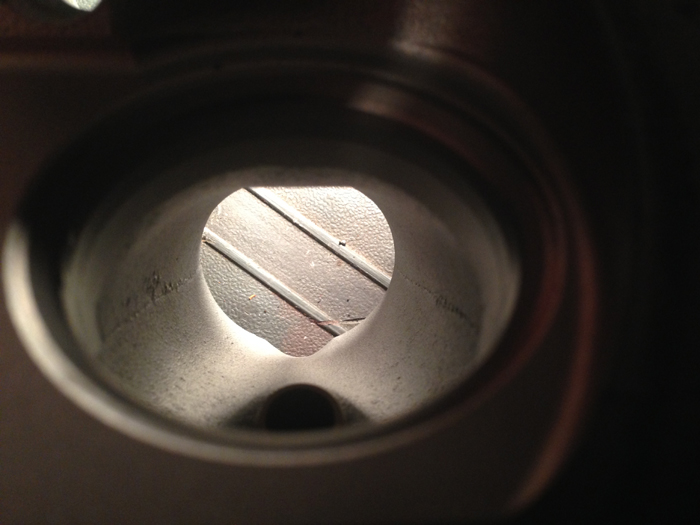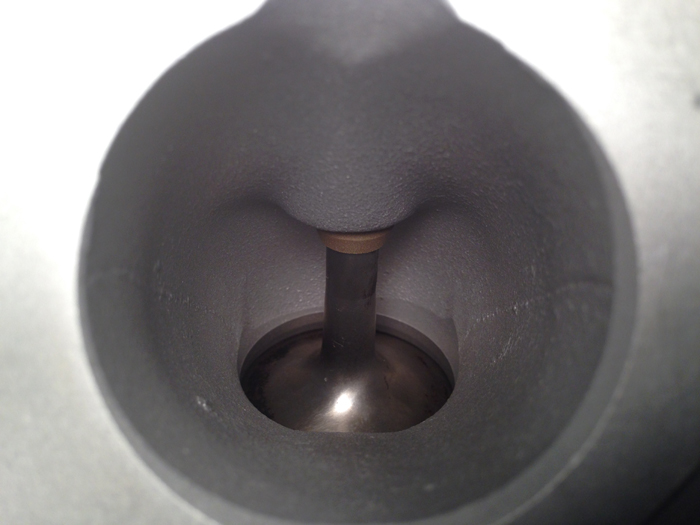Ultra High Flow, Low Cost, 8V Head Project
#17
#19
Burning Brakes
I always thought the flat spot on the port floor was to help maintain a large, gentle short side radius.
Anyone notice the ridges formed where the machining stopped below the seat?
Anyone notice the ridges formed where the machining stopped below the seat?
#20
Rennlist Member
Thread Starter
Yes, did see it and I just watched it again. Intuitively it seems to make sense to me that removing much of the short side radius would help but it looks intentional. I want to understand why it is this way. Removing the short side radius may improve static flow but the port is highly dynamic. Sometimes things like this can be done to improve reversion that do not show up on a static flow bench.
#21
Rennlist Member
Good question on that flat spot... and I'd only be speculating if I made a guess... but perhaps it is in some way done like that to balance the valve guide on the opposite side?
Or maybe it was just a more simple way to manufacture it... I assume these heads are sand cast? They would have made positive runners out of sand with binder (you can see the joint lines for those pieces) and then those would have been placed inside a larger sand mold so the molten aluminum could be poured in. Then sand parts would be broken and fall out.
How thick is the wall section there between the intake and the water jacket? Maybe they were just trying to keep a minimum thickness?
Or maybe it was just a more simple way to manufacture it... I assume these heads are sand cast? They would have made positive runners out of sand with binder (you can see the joint lines for those pieces) and then those would have been placed inside a larger sand mold so the molten aluminum could be poured in. Then sand parts would be broken and fall out.
How thick is the wall section there between the intake and the water jacket? Maybe they were just trying to keep a minimum thickness?
#24
Race Car
Flat spot only tells part of the story, but it is absolutely critical to making good flow. When Michael Mount was in another thread talking about the shape of the port, that's the kind of thing he mentioned.
The floor gets flat during turns. It actually becomes shaped more like a D. The reason is that you are trying to fight the air's momentum. As you try to turn the port, the air wants to keep going forward. So the air on the bottom will want to shoot forward, and create a vena contracta on the floor. What you can do, however, is slow down that air. You slow it down by increasing the area. Now, it goes from being at the bottom of a circle, where there is little area, to a flat spot. So that widens it out pretty significantly. In doing so, you will want to slow down the air.
So overall, you are increasing the area at the bottom of the port relative to the top. You make the top smaller, and that speeds up the air. You make the bottom wider that slows it down. Another way to think about this is simple geometry. Going around the outside of a circle requires you to cover more distance. Going on the inside, less. Well, if you have a finite amount of time (rather than a finite speed) to get around a circle, you will have to go faster around the outside, and more slowly on the inside, to get around in the same amount of time.
So it is all about manipulating the velocity of the air from top (fastest) to bottom (slowest) to help it turn. Make sense?
The floor gets flat during turns. It actually becomes shaped more like a D. The reason is that you are trying to fight the air's momentum. As you try to turn the port, the air wants to keep going forward. So the air on the bottom will want to shoot forward, and create a vena contracta on the floor. What you can do, however, is slow down that air. You slow it down by increasing the area. Now, it goes from being at the bottom of a circle, where there is little area, to a flat spot. So that widens it out pretty significantly. In doing so, you will want to slow down the air.
So overall, you are increasing the area at the bottom of the port relative to the top. You make the top smaller, and that speeds up the air. You make the bottom wider that slows it down. Another way to think about this is simple geometry. Going around the outside of a circle requires you to cover more distance. Going on the inside, less. Well, if you have a finite amount of time (rather than a finite speed) to get around a circle, you will have to go faster around the outside, and more slowly on the inside, to get around in the same amount of time.
So it is all about manipulating the velocity of the air from top (fastest) to bottom (slowest) to help it turn. Make sense?
#25
Rennlist Member
Thread Starter
#26
That makes perfect sense....Thanks for that 

Flat spot only tells part of the story, but it is absolutely critical to making good flow. When Michael Mount was in another thread talking about the shape of the port, that's the kind of thing he mentioned.
The floor gets flat during turns. It actually becomes shaped more like a D. The reason is that you are trying to fight the air's momentum. As you try to turn the port, the air wants to keep going forward. So the air on the bottom will want to shoot forward, and create a vena contracta on the floor. What you can do, however, is slow down that air. You slow it down by increasing the area. Now, it goes from being at the bottom of a circle, where there is little area, to a flat spot. So that widens it out pretty significantly. In doing so, you will want to slow down the air.
So overall, you are increasing the area at the bottom of the port relative to the top. You make the top smaller, and that speeds up the air. You make the bottom wider that slows it down. Another way to think about this is simple geometry. Going around the outside of a circle requires you to cover more distance. Going on the inside, less. Well, if you have a finite amount of time (rather than a finite speed) to get around a circle, you will have to go faster around the outside, and more slowly on the inside, to get around in the same amount of time.
So it is all about manipulating the velocity of the air from top (fastest) to bottom (slowest) to help it turn. Make sense?
The floor gets flat during turns. It actually becomes shaped more like a D. The reason is that you are trying to fight the air's momentum. As you try to turn the port, the air wants to keep going forward. So the air on the bottom will want to shoot forward, and create a vena contracta on the floor. What you can do, however, is slow down that air. You slow it down by increasing the area. Now, it goes from being at the bottom of a circle, where there is little area, to a flat spot. So that widens it out pretty significantly. In doing so, you will want to slow down the air.
So overall, you are increasing the area at the bottom of the port relative to the top. You make the top smaller, and that speeds up the air. You make the bottom wider that slows it down. Another way to think about this is simple geometry. Going around the outside of a circle requires you to cover more distance. Going on the inside, less. Well, if you have a finite amount of time (rather than a finite speed) to get around a circle, you will have to go faster around the outside, and more slowly on the inside, to get around in the same amount of time.
So it is all about manipulating the velocity of the air from top (fastest) to bottom (slowest) to help it turn. Make sense?
#27
Rennlist Member
Thread Starter
49 mm intake valves arrived from SI today. I weighed them along with the OEM valves:
OEM 45 mm Intake Valve: 108 grams
OEM 40 mm Exhaust Valve: 108 grams
SI 49 mm Intake Valve: 118 grams
Here are a few pics:
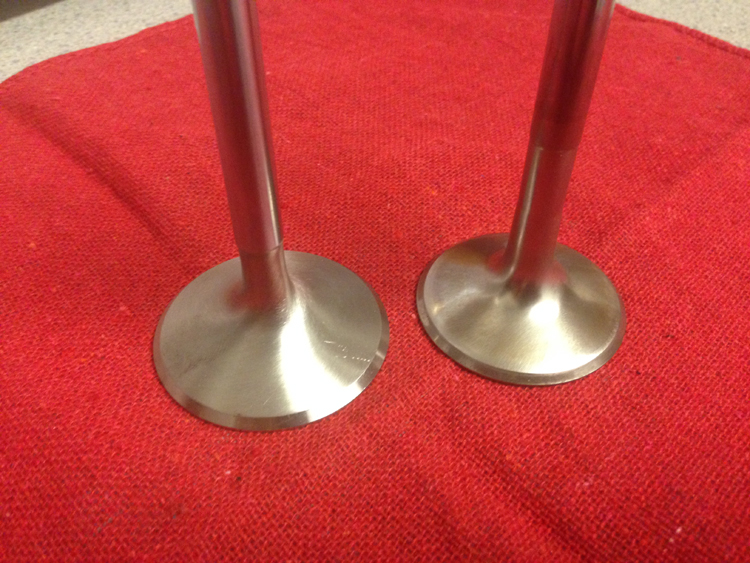
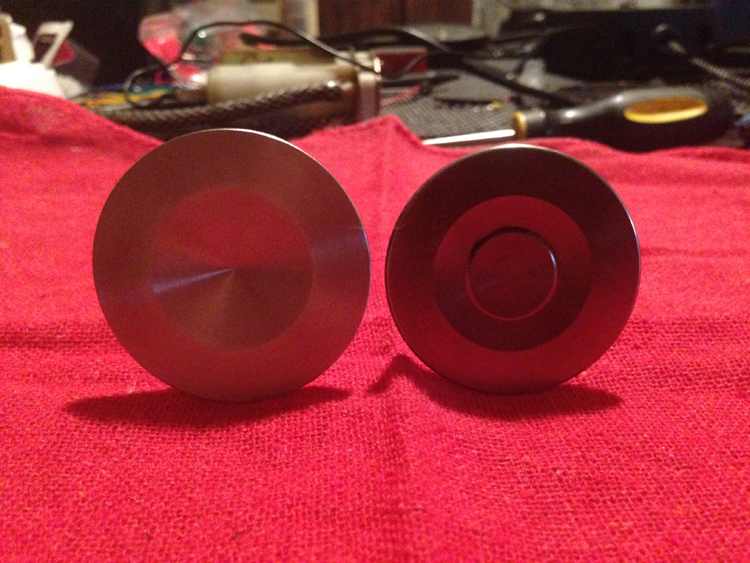
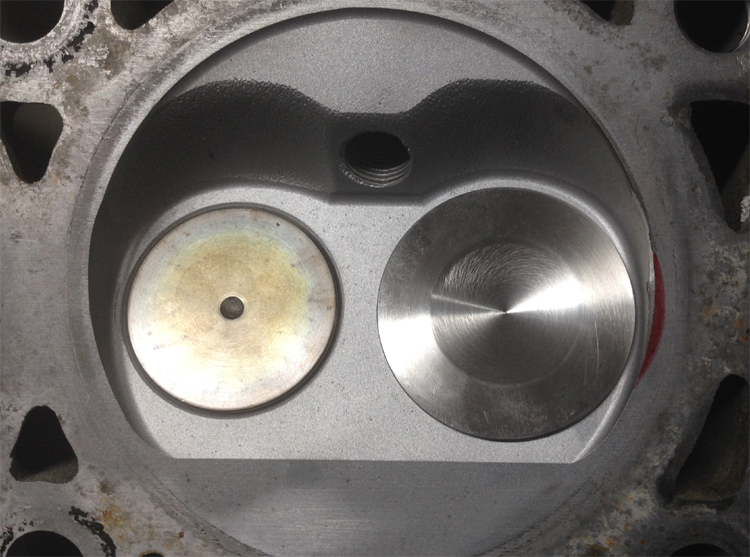
OEM 45 mm Intake Valve: 108 grams
OEM 40 mm Exhaust Valve: 108 grams
SI 49 mm Intake Valve: 118 grams
Here are a few pics:



#29
Rennlist Member
Thread Starter
#30
Addict
Rennlist Member
Rennlist Member
OE 48mm intake valve = 111g


